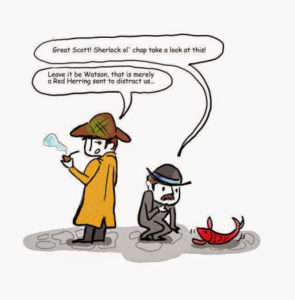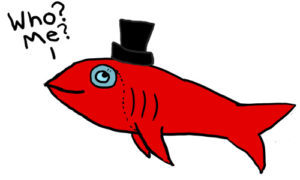The Red Herring.
 I spoke about foreshadowing earlier, see the link here, I even discussed the use of dreams as a literary device here. Today, I would like to cover the opposite to these devices more commonly referred to as the red herring. The red herring is quite simply a device where the writer intentionally puts a clue to something that is happening that is not quite true.
I spoke about foreshadowing earlier, see the link here, I even discussed the use of dreams as a literary device here. Today, I would like to cover the opposite to these devices more commonly referred to as the red herring. The red herring is quite simply a device where the writer intentionally puts a clue to something that is happening that is not quite true.
This is very common in mystery or horror genres, but it has cropped up from time to time in others.
The effect is best seen as a clue that gives the reader the wrong impression about something that happened. In the mystery genre it is best seen as a clue that leads the reader and the character up the garden path. Like wolf prints near a murder scene, it leads the character to think that the wolf killed the hapless victim only to find the den of the wolves no more that three metres away from the scene, and had no part in the murder.
There are authors that use it intentionally, Agatha Christie’s Ten Little Indians is a good example of a red herring, the fourth last person to die, was discovered to be missing and it was assumed by the characters and the reader to be the murderer, only for the body to be found washed up on the shore later.
The use of a red herring can be for several reasons, in the murder genre it can show the investigator working through the clues and chasing down every clue before coming to the right answer. The other example could simply be a hat off to the reader. Like in Dan Browns Da Vinci code when the person thought to be behind the whole conspiracy turns out not to be, but the characters name is in fact Latin for Red herring. Here the writer wrote a red herring into the book not to demonstrate investigative skill but more as a tip off to the readers to see if they were watching and paying attention.
However, there is a case in JK Rowling’s books where in the first couple of books it is implied that Snape and Malfoy are working together when they aren’t, but she flips it on its head when they actually start working together. This was certainly a nod to the readers of the previous books in  acknowledging the red herring and proving them right.
acknowledging the red herring and proving them right.
Unlike foreshadowing where the writer clues the reader into things that will happen, the red herring is more a nod to the readers, to keep them on their toes.
Should we as writers use red herrings? I think we should, we do need to be careful in crafting anything in our books but we shouldn’t shy away from the use of this trope simply because we are either new writers or because it has been done so many times. Tropes are like tools in a carpenter’s belt, “you expect him to use the tools in a way that helps him build what he needs, not to discard them saying, I don’t use them because every other carpenter uses them”.
Keep reading and Keep writing.
Peter.



